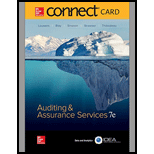
Compute the sample rate of deviation, ULRD, and allowance for sampling risk for each condition and write the comments for the relationship of each factor to the ULRD.
Explanation of Solution
Attributes sampling: Attributes sampling helps the auditor to assess a specific rate of occurrence for a specific characteristic of the audit population. It is helpful in finding the estimate related to a particular transaction or activity in the system.
Sample rate of deviation: It is a rate of deviation that ascertains the percentage of occurrence and accuracy of control. Sample rate of deviation is calculated by using the following formula:
Upper Limit Rate of Deviation (ULRD): It is an adjusted deviation rate that ascertains a conservative measure of the population rate of deviation and allows the auditor to control the disclosure of sampling risk to acceptable levels.
Allowance for sampling risk: It is the “adjustment” of the sample deviation rate for the acceptable risk of overreliance. Allowance for sampling risk is calculated by using the following formula:
a. Compute the sample rate of deviation, ULRD, and allowance for sampling risk:
- 1. Compute the sample rate of deviation:
- 2. Ascertain the ULRD by using AICPA sample evaluation tables:
According to the AICPA sample evaluation tables, the ULRD for 4 deviations of 60 sample size at 5% risk of overreliance is 14.7%.
- 3. Ascertain the allowance for sampling risk:
Hence, the sample rate of deviation, upper limit rate of deviation and allowance for sampling risk is 8%, 14.7% and 8% respectively.
b. Compute the sample rate of deviation, ULRD, and allowance for sampling risk:
- 1. Ascertain the sample rate of deviation:
- 2. Ascertain the ULRD by using AICPA sample evaluation tables:
According to the AICPA sample evaluation tables, the ULRD for 6 deviations of 60 sample size at 5% risk of overreliance is 18.8%.
- 3. Ascertain the allowance for sampling risk:
Hence, the sample rate of deviation, upper limit rate of deviation and allowance for sampling risk is 10%, 18.8% and 8.8% respectively.
c. Compute the sample rate of deviation, ULRD, and allowance for sampling risk:
- 1. Ascertain the sample rate of deviation:
- 2. Ascertain the ULRD by using AICPA sample evaluation tables:
According to the AICPA sample evaluation tables, the ULRD for 6 deviations of 60 sample size at 10% risk of overreliance is 16.9%.
- 3. Ascertain the allowance for sampling risk:
Hence, the sample rate of deviation, upper limit rate of deviation and allowance for sampling risk is 10%, 16.9% and 6.9% respectively.
Write the comments for the relationship of each factor to the ULRD:
The difference of ULRD in (a) and (b) is due to increase in number of deviation from 4 (in a) to 6 (in b). Here, the increase in ULRD from 14.7% to 18.8% indicates that the number of deviations and sample rate of deviation is directly proportional to ULRD.
The difference of ULRD in (b) and (c) is due to increase in the risk of overreliance from 5% (in b) to 10% (in c). Here, the decrease in ULRD from 18.8% to 16.9% indicates that the risk of overreliance is inversely proportional to ULRD.
Want to see more full solutions like this?
Chapter F Solutions
Connect Access Card for Auditing & Assurance Services

 AccountingAccountingISBN:9781337272094Author:WARREN, Carl S., Reeve, James M., Duchac, Jonathan E.Publisher:Cengage Learning,
AccountingAccountingISBN:9781337272094Author:WARREN, Carl S., Reeve, James M., Duchac, Jonathan E.Publisher:Cengage Learning, Accounting Information SystemsAccountingISBN:9781337619202Author:Hall, James A.Publisher:Cengage Learning,
Accounting Information SystemsAccountingISBN:9781337619202Author:Hall, James A.Publisher:Cengage Learning, Horngren's Cost Accounting: A Managerial Emphasis...AccountingISBN:9780134475585Author:Srikant M. Datar, Madhav V. RajanPublisher:PEARSON
Horngren's Cost Accounting: A Managerial Emphasis...AccountingISBN:9780134475585Author:Srikant M. Datar, Madhav V. RajanPublisher:PEARSON Intermediate AccountingAccountingISBN:9781259722660Author:J. David Spiceland, Mark W. Nelson, Wayne M ThomasPublisher:McGraw-Hill Education
Intermediate AccountingAccountingISBN:9781259722660Author:J. David Spiceland, Mark W. Nelson, Wayne M ThomasPublisher:McGraw-Hill Education Financial and Managerial AccountingAccountingISBN:9781259726705Author:John J Wild, Ken W. Shaw, Barbara Chiappetta Fundamental Accounting PrinciplesPublisher:McGraw-Hill Education
Financial and Managerial AccountingAccountingISBN:9781259726705Author:John J Wild, Ken W. Shaw, Barbara Chiappetta Fundamental Accounting PrinciplesPublisher:McGraw-Hill Education





